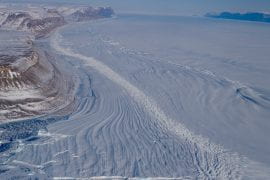An almost-bound isotope of oxygen undergoes four-neutron decay that challenges theory.
Latest News
Entanglement Entropies of Nuclear Systems Grow as the Volume of those Systems
Quantum entanglement changes in atomic nuclei in ways that differ from other systems.
Teasing Strange Matter from Ordinary
New insights reveal details of how strange matter forms.
Searching for the Decay of Nature’s Rarest Isotope: Tantalum-180m
The first results from the MAJORANA experiment dramatically improve current limits on this rare isotope’s decay.
Grounding zone discovery explains accelerated melting under Greenland’s glaciers
UC Irvine researchers suggest we may be underestimating severity of sea level rise
Measuring the Thickness of the Neutron Skin with Ultra-Relativistic Heavy Ion Collisions
Researchers determined the neutron skin of lead-208 from experimental data collected in lead-lead collisions at the CERN Large Hadron Collider.
UC Irvine study: vehicle brakes produce charged particles that may harm public health
The work could help efforts to contain an important source of air pollution
Statisticians and Physicists Team Up to Bring a Machine Learning Approach to Mining of Nuclear Data
Bayesian statistical methods help improve the predictability of complex computational models in experimentally unknown research.
Reines Lecture at UC Irvine: UCLA astronomer and Nobel laureate Andrea Ghez
EVENT: 2024 Reines Lecture: “From the possibility to the certainty of a supermassive black hole” WHEN/WHERE: 6:30 p.m. Tuesday, March 12, Irvine Barclay Theater, UC Irvine campus. INFORMATION: Media planning to attend should contact Brian Bell at 949-565-5533 or [email protected]. Attendance and parking are complimentary for media who RSVP in advance. BACKGROUND: The 2024 Reines […]
The “Nested Doll” Nucleus Nitrogen-9 Stretches the Definition of a Nucleus to the Limit
Nitrogen-9 has only two neutrons to its seven protons and decays to an alpha particle by emitting five of its protons in stages.










